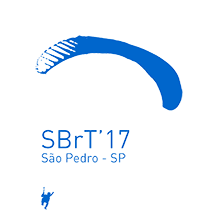
XXXV Simpósio Brasileiro de Telecomunicações e Processamento de Sinais
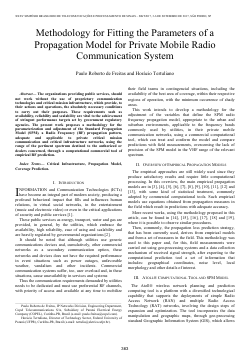
Methodology for Fitting the Parameters of a Propagation Model for Private Mobile Radio Communication System
Paulo Roberto de Freitas, Horácio Tertuliano
DOI: 10.14209/sbrt.2017.194
Keywords: Critical Infrastructure Propagation Model Coverage Prediction
Abstract
The organizations providing public services, should not work without the use of proprietary communication technologies and critical mission infrastructure, which provide, to their actions and operations, the absolutely necessary conditions to carry out their purposes. These requirements such as availability, reliability and scalability are vital to the achievement of stringent performance targets set by government regulatory agencies. The present work proposes a methodology for the parameterization and adjustment of the Standard Propagation Model (SPM), a Radio Frequency (RF) propagation pattern, adequate and applicable to private critical mission communication and critical infrastructure networks, using the range of the pertinent spectrum destined to the authorized or dealers concerned, through a computational commercial tool of empirical RF prediction.Download

Análise de Transiente do Algoritmo ℓ0-sign-LMS
Leonardo O. Santos, Diego B. Haddad, Mariane R. Petraglia
DOI: 10.14209/sbrt.2017.195
Keywords: Adaptive filtering recursive autocorre- lation matrix calculation ℓ0-sign-LMS sparse system identification transient analysis
Abstract
Sparse systems are common in the most diverse areas of application of adaptive filtering, in- cluding control, biomedical engineering and echo can- cellation. Algorithms capable of using this property to accelerate convergence and/or improve steady state error are gaining increasing prominence in the acade- mic community. Motivated by these experiences, this work presents a theoretical analysis of the transient and steady-state performances of the ℓ0-sign-LMS algo- rithm, which presents the desired convergence proper- ties for sparse systems, as well as robustness to impul- sive noise and reduced computational complexity. The analysis is performed through the recursive calculation of the autocorrelation matrix of the coefficient deviati- ons, adopting some assumptions commonly used in the literature, but not the very frequent hypothesis that the input signal is white. At the end, several simulation results are presented to evaluate the performance of the proposed stochastic model.Download
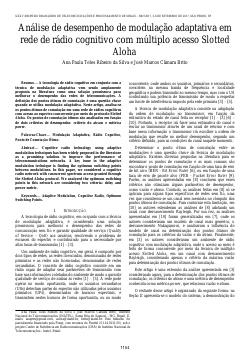
Análise de desempenho de modulação adaptativa em rede de rádio cognitivo com múltiplo acesso Slotted Aloha
Ana Paula Teles Ribeiro da Silva, José Marcos Câmara Brito
DOI: 10.14209/sbrt.2017.174
Keywords: Adaptive Modulation Cognitive Radio Optimum Switching Points
Abstract
Cognitive radio technology using adaptive modulation techniques has been widely proposed in the literature as a promising solution to improve the performance of telecommunications networks. A key issue in the adaptive modulation technique is finding the optimum switching points between modulations. In this paper, we considered a cognitive radio network with concurrent spectrum access granted through the Slotted Aloha protocol. We analyzed the optimum switching points in this network are considering two criteria: delay and power metric.Download
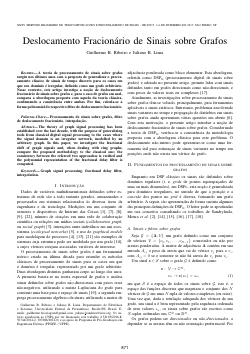
Deslocamento Fracionario de Sinais sobre Grafos
Guilherme B. Ribeiro, Juliano B. Lima
DOI: 10.14209/sbrt.2017.196
Keywords: Graph signal processing fractional delay filter interpolation
Abstract
The theory of graph signal processing has been established over the last decade, with the purpose of generalizing tools from classical digital signal processing to the cases where the signal domain is an irregular network, modelled by an arbitrary graph. In this paper, we investigate the fractional shift of graph signals and, when dealing with ring graphs, compare the proposed methodology to the classical one; the consistency between the referred two approaches is verified and the polynomial representation of the fractional delay filter is computed.Download
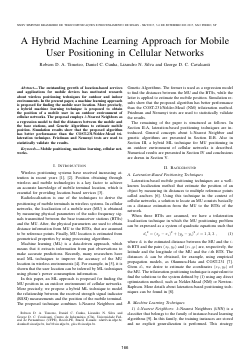
A Hybrid Machine Learning Approach for Mobile User Positioning in Cellular Networks
Robson D. A. Timoteo, Daniel C. Cunha, Lizandro N. Silva, George D. C. Cavalcanti
DOI: 10.14209/sbrt.2017.172
Keywords: Mobile positioning machine learning cellular net- works
Abstract
The outstanding growth of location-based services and applications for mobile devices has motivated research about wireless positioning techniques for outdoor and indoor environments. In the present paper, a machine learning approach is proposed for finding the mobile user location. More precisely, a hybrid machine learning technique is proposed to obtain the position of a mobile user in an outdoor environment of cellular networks. The proposal employs k-Nearest Neighbors as a regression model to find the distances between the mobile and the base stations, and Genetic Algorithms to estimate mobile position. Simulation results show that the proposed algorithm has better performance than the COST-231/Nelder-Mead tri- lateration technique. Friedman and Nemenyi tests are used to statistically validate the results.Download

Dual Connectivity for LTE-NR Cellular Networks
Roberto P. Antonioli, Gabriela C. Parente, Tarcisio F. Maciel, Fco. Rodrigo P. Cavalcanti, Carlos F. M. e Silva, Emanuel B. Rodrigues
DOI: 10.14209/sbrt.2017.173
Keywords: 5G Dual Connectivity Multiple Radio Access Technologies Radio Resource Management
Abstract
The Dual Connectivity (DC) technology has gained a lot of momentum in the LTE Release 12 as a means to enhance the per-user throughput and provide mobility robustness. Some studies in the literature have discussed a coupling between the LTE and the air interface of the upcoming Fifth Generation (5G) in a DC scenario. That integration may provide some benefits to meet the high throughput demands, reliability and availability requirements of the 5G networks. This paper presents a brief overview of the DC technology considering the inter-generations coupling and discusses some challenges involving Radio Resource Management (RRM) in such scenario.Download
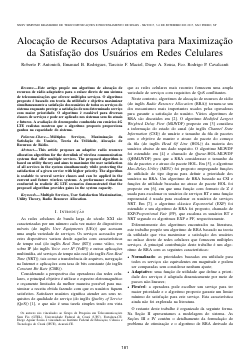
Alocação de Recursos Adaptativa para Maximização da Satisfação dos Usuários em Redes Celulares
Roberto P. Antonioli, Emanuel B. Rodrigues, Tarcisio F. Maciel, Diego A. Sousa, Fco. Rodrigo P. Cavalcanti
DOI: 10.14209/sbrt.2017.178
Keywords: Multiple Services User Satisfaction Maximization Utility Theory Radio Resource Allocation
Abstract
This article proposes an adaptive radio resource allocation algorithm for the downlink of wireless communication systems that offer multiple services. The proposed algorithm is based on utility theory and aims to maximize the user satisfaction of all services in the system simultaneously while protecting the satisfaction of a given service with higher priority. The algorithm is scalable to several service classes and can be applied in the current and future wireless systems. A performance evaluation conducted in realistic 4G LTE scenarios demonstrated that the proposed algorithm provides gains in the system capacity.Download

Aplicação de Máquinas de Aprendizado Extremo ao Problema de Identificação de Sistemas Não-Lineares
Renan D. B. Brotto, Levy Boccato, João M. T. Romano
DOI: 10.14209/sbrt.2017.180
Keywords: Nonlinear system identification Artificial neural networks Extreme learning machines
Abstract
This work proposes the application of extreme learning machines to the problem of nonlinear system identifi- cation. Such structure constitutes a promissing option because it presents the capability of approximating nonlinear mappings and simplicity in the process of parameter adaptation. The proposed strategy is analyzed in a scenario related to the control system of a pneumatic valve, being compared with two other models based on multilayer perceptron networks. The obtained results show that the ELM is very suitable for the task.Download
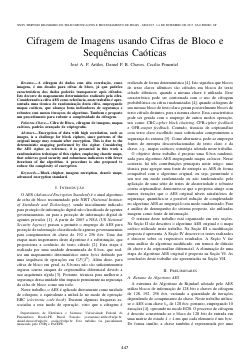
Cifragem de Imagens usando Cifras de Bloco e Sequências Caóticas
José A. P. Artiles, Daniel P. B. Chaves, Cecilio Pimentel
DOI: 10.14209/sbrt.2017.186
Keywords: Cifra de Bloco cifragem de imagens mapas caóticos padrão avançado de criptografia
Abstract
A cifragem de dados com alta correlação, como imagens, é um desafio para cifras de bloco, já que padrões característicos dos dados poderão transparecer após cifrados. Isto decorre do mapeamento determinístico realizado pela cifra. Considerando a cifra AES como referência, neste trabalho é apresentada uma técnica de randomização desta cifra, empregando mapas caóticos, que alcança bons indicadores de segurança e robustez com menos iterações do algoritmo. Também é proposto um procedimento para reduzir a complexidade da cifragem.Download

Impacto da Interferência da Rede Primária em Redes Cooperativas e Cognitivas Multiusuário do Tipo Underlay
L. F. Vasconcelos Peres, M. Komono Tojeiro, D. P. Moya Osorio, E. E. Benitez Olivo
DOI: 10.14209/sbrt.2017.198
Keywords: Compartilhamento espectral diversidade cooperativa diversidade multiusuário interferência redes cooperativas e cognitivas
Abstract
Este artigo investiga o efeito da interferência da rede primária sobre o desempenho de uma rede cooperativa-cognitiva, baseada no protocolo amplifica-e-encaminha. Visando explorar a diversidade multiusuário na rede secundária, quatro critérios diferentes de seleção do nó destino são considerados. Assume-se que a potência transmitida dos nós secundários é restringida pela temperatura de interferência e pela potência máxima disponível em cada nó e que uma combinação por razão máxima dos sinais provenientes da fonte e do relay é realizada no destino. O ´ desempenho do sistema é avaliado em termos da probabilidade de outage, através de simulações exaustivas de Monte Carlo.Download